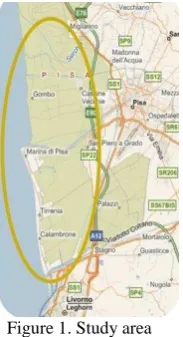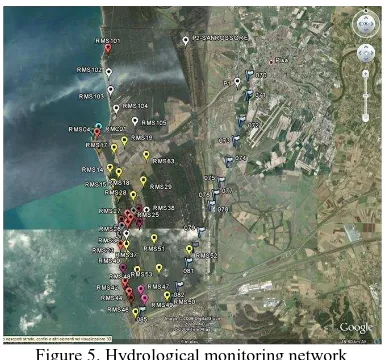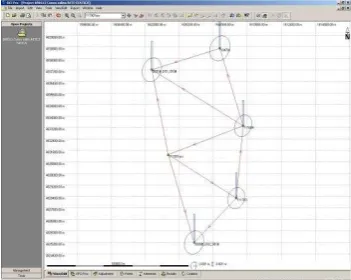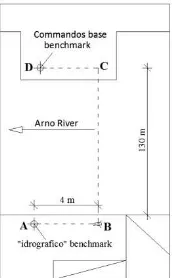THE ELEVATION NET FOR THE SALTWATER INTRUSION PHENOMENON
ANALYSIS IN THE COASTAL PLAIN OF PISA
G. Caroti a, A. Piemonte a, M. Redini b
a Laboratorio A.S.T.R.O., Dipartimento di Ingegneria Civile e Industriale, Università di Pisa, Largo Lucio Lazzarino 1
56123 PISA, tel 050 221 7770, fax 050 221 7779, e-mail [email protected] b Comune di Pisa, [email protected]
KEY WORDS: Surveying, Hydrology, Environment, DEM/DTM, LIDAR, Georeferencing, Model
ABSTRACT:
In coastal plains, such as that of Pisa, with particular reference to groundwater, the marine intrusion phenomenon occurs not only through the freshwater/saltwater interface in the aquifer along the shore line, but also by the rise of the salt wedge in water courses, in case they are in hydraulic connection with the aquifer itself. The depth of the interface is primarily regulated by the hydrostatic freshwater/saltwater balance, that can be modified by anthropic exploitation of groundwater. To this day, seawater intrusion is considered one of the most extensive and important processes that degrade water quality through an increase in salinity levels up to values exceeding the standard for drinking water and irrigation systems, and endangering the future use of coastal waters. Given the potential hazard of the phenomenon, control wells are set up in order to monitor its evolution, allowing to perform routine in-well analyses aimed at measuring its characteristic parameters.
The essential foundation to reconstruct the freshwater/saltwater interface, and therefore also for the recognition of the phenomenon of seawater intrusion, is represented by piezometric reconstructions integrated with hydrogeochemical information that can be obtained directly from in-well measurements and indirectly through laboratory tests carried out on samples of water. A serious limitation of the piezometric reconstructions is mostly represented by the margin of approximation with which the elevation of water points has been established, which in turn result in uncertainty in the relationship between piezometric and hydrometric elevation. This paper presents various methodologies, GNSS and conventional, to determine the elevation of piezometers , also evaluating the accuracy obtainable and the requirements in terms of time, personnel and equipment.
1. INTRODUCTION
This work is part of a collaboration with the Municipality of Pisa - Office of Regional Planning for the study of saltwater intrusion on the Pisa coast.
In 2007, the City of Pisa has started the project "Implementation of a network for measurement, control and monitoring in the coastal plain of Pisa for the protection of water resources from salt wedge intrusion and other degradation".
It's long been known that the salinity of Pisa coastal freshwater is growing. Since 2007, the Municipality of Pisa is reconstructing, through the relevant observations, the trend, in both space and time, of the phenomenon, aiming at the identification of effective actions to mitigate it, in accordance with:
- the Regulation implementing Article 62 of the LR 03.01.05 n. 1 (Regulations for the government of the territory) in the field of geological investigations;
- competences entrusted by Del. C. R. 30.01.90 n.47 (Directive on coastal areas);
- L.R. 21.05.07 n. 29 and subsequent amendments (Hydraulic emergencies).
There is an ongoing data collection activity aimed at:
- updating and detailed definition of the required knowledge base;
- implementing the Directive on coastal areas (salt wedge progression);
- updating of hydrogeological vulnerability maps accompanying the “Piano Strutturale”;
- creating a detailed cognitive framework to be made available to higher-level authorities and users
The objectives of this study are:
- the definition of salt wedge movements on the coast of Pisa in response to hydrological stress and water management practices in the surface aquifer;
- the definition of temporary safeguard measures;
- the definition of mitigation actions.
-The study area extends from the mouth of Fiume Morto Vecchio to the mouth of Calambrone, and coincides with the boundaries of the Municipality overlooking the coast, for a total of about 20 km, 12 of which related to the stint Marina di Pisa-Calambrone (Figure 1 ).
The area is subject to multiple hydrological stress linked to incorrect practices of water resource management, which can be summarized as follows:
- coastline recession;
- pumping;
- anthropogenic pressure (urban planning tools);
- riverbeds (suspended riverbeds);
- drainage system (minor networks, dewatering pumps).
Central to these primary objectives, is the need to unambiguously and correctly georeference the different databases coming from the various monitoring activities implemented for the study of the phenomenon.
Figure 1. Study area
In this context, starting Jun 2009, the authors’ contributions to the project of the Municipality included:
- local check of the geoid model provided by the National Military Geographical Institute (Istituto Geografico Militare – IGM);
- measure of orthometric height in the vicinity of piezometric wells;
- fixing of plano-altimetric position of network piezometers in the area of monitoring, showing applicable survey methods, taking into account not only the different levels of accuracy but also the requirements as for time, personnel and equipment resources.
2. THE PHENOMENON OF SALT WEDGE
In coastal plains, such as that of Pisa, with particular reference to groundwater, the marine intrusion phenomenon occurs not only in the aquifer along the shoreline through the freshwater / saltwater interface, but also by the rise of the salt wedge in water courses , in case these are in hydraulic connection with the aquifer itself.
The depth of the interface is primarily regulated by hydrostatic freshwater / saltwater balance, whose natural trend is modified by anthropic exploitation of groundwater.
Seawater intrusion is currently seen as one of the most extensive and important processes that degrade water quality, through an increase in the salinity level up to values exceeding the standard for drinking water and irrigation, also endangering future use of coastal waters.
In order to monitor the evolution of this potentially harmful phenomenon, control wells are set up to perform the routine analysis aiming to measure characteristic parameters of seawater intrusion.
The indispensable basis for reconstituting the freshwater / saltwater interface trend, and therefore also for the recognition of seawater intrusion phenomena, is represented by piezometric reconstructions, integrated with hydrogeochemical information obtained directly from in-well measurements and indirectly through laboratory tests carried out on samples of water. A major limitation of piezometric reconstruction is mostly represented by the approximation with which the elevation of water points has been determined, which in turn results in problems of uncertainty in relating piezometric and hydrometric elevation.
3. GEOLOGICAL AND HYDROGEOLOGICAL
MODELS
The Municipality of Pisa, in the study for the protection of water resources from salt wedge progression, has reconstructed a geological model of the subsurface referring the height of geognostic probing to an elevation model (DTM) derived from laser scanner surveys, available for the entire study area.
Figure 2. Geological model.
Based upon this subsurface geological model, a hydrogeological model, greatly detailing just the coastal strip and a wide area one, has been implemented.
The finite difference model ("visual modulo" software) set up for the hydrogeological modeling has the following features:
- resolution of the model in the large triangular area bound to the north by the Arno river, from the south to the east by the Scolmatore-Navicelli channel and to the west from the sea: 120 m by 133 m cells;
- resolution of the model in the town of Marina di Pisa and inland dunes: 68 m by 58 m cells;
- resolution of the model in the center of Tirrenia and inland dunes: 72 m by 68 m cells.
The modeling results have provided quality, high-reliability data.
By way of example, Figure 3 shows the basic scenario for the area of Tirrenia, while Figure 4 shows the scenario with local reduction of the charge for the area of Marina di Pisa.
Figure 3. Baseline scenario for the Tirrenia area (3D view obtained by Modflow 3D Visual Explorer). Salinity distribution
(mg/l) at the end of the simulation period (2017)
Figure 4. Scenario with local reduction of the charge for urban areas in the Marina di Pisa area (3D view obtained by Modflow 3D Visual Explorer). Salinity distribution at -6m m a.s.l. (mg/l)
at the end of the simulation period (2017)
In order to compare the simulated information from the model with the actual situation of each location and to continuously collect hydrogeological information, 48 measurement points have been selected to set up a hydrological monitoring network.
Figure 5. Hydrological monitoring network
The use of data provided by fixed control points on the territory as input for simulation models has required a previous check of the elevation of the well heads over the entire monitoring network and has led to a detailed analysis of different applicable survey methods.
4. PLANO-ALTIMETRIC GEOREFERENCING OF
PIEZOMETRIC WELLS
The planimetric and altimetric coordinates of the 10 piezometric wells located along the Pisa coast have been determined by means of a real-time, phase differential GNSS survey.
In particular, a Leica GPS1200+ system, connected via GPRS modem to the Italpos network server, has been used. The selected differential correction was single station CMR (Nearest) compared to the datum ETRS89 so that data were consistent with the other databases used.
Figure 6. Location of surveyed wells
Since Italpos network station 0056 (Mada) is less than twelve kilometers away from the area in question, mode "Nearest" was chosen for consistency in the differential correction.
The accuracy degree of the survey was aligned with that expected from the methodology used (Table 1).
Well Latitude Longitude hell (m) hell STD (m)
RMS01 43°40'44.44661"N 10°16'28.81194"E 47.216 0.008
RMS04 43°40'35.45364"N 10°16'25.01387"E 47.426 0.011
RMS16 43°40'05.15265"N 10°16'30.16503"E 49.229 0.013
RMS14 43°39'29.59786"N 10°16'58.69312"E 48.585 0.018
RMS18 43°39'21.08594"N 10°17'20.24294"E 47.517 0.022
RMS15 43°39'02.74095"N 10°17'06.23424"E 50.000 0.013
RMS29 43°39'06.57516"N 10°18'22.53573"E 47.159 0.033
RMS63 43°39'53.44377"N 10°18'29.78764"E 47.048 0.011
RMS17 43°40'06.09466"N 10°17'08.30390"E 46.889 0.027
RMS19 43°40'19.77974"N 10°17'34.35587"E 47.070 0.014
RTCM
Ref 0056 43°44'50.95870"N 10°21'57.83046"E 56.871 0.000
Table 1. Coordinates of wells by RTK.
To make the coordinates consistent with piezometric data, they have been transformed into Gauss-Boaga and orthometric height using *.gr2 IGM grids (Table 2).
Well North Roma40 (m) East Roma40 (m) Ha.s.l.(m)
RMS01 4837027.970 1602773.644 0.745
RMS04 4836749.218 1602692.857 0.944
RMS16 4835816.156 1602822.565 2.712
RMS14 4834729.083 1603478.415 2.024
RMS18 4834473.956 1603965.185 0.946
RMS15 4833903.120 1603660.154 3.404
RMS29 4834048.092 1605367.575 0.568
RMS63 4835496.619 1605507.237 0.518
RMS17 4835858.398 1603676.245 0.374
RMS19 4836289.668 1604253.105 0.572
Table 2. Cartographic coordinates Gauss-Boaga (North, East) and elevation above mean sea level of well heads.
In two of the piezometric wells (RMS01 and RMS04) check points were materialized at the side of the well head within the same casing, while in the remaining cases the same spot used for piezometric level measurements, on the edge of the PVC pipe coating the well, has been used.
Transformation from ellipsoidal to orthometric heights, through the undulation provided by *.gr2 IGM grids, has been tested in the field, as shown in the next section.
5. VERIFICATION OF ACCURACY OF GEOID MODEL PROVIDED BY IGM IN THE MONITORING
AREA
The network of piezometric wells surveyed covers the area between the mouth of the Arno River and the mouth of Calambrone, for a total of about 12 km.
Figure 7. Survey area
In this area, IGM leveling lines do not run along the coast, as shown in Figure 8, and benchmark “104610”, placed near the mouth of Arno along its left bank on the Lamone canal bridge, has been torn, presumably due to road maintenance. The only extant benchmark next to the monitoring area is that on the right bank of Arno (0031#_D01_010 #), on the platform of the Italian Navy Commandos base.
Figure 8. Distribution of leveling lines along the Pisa coast
In order to verify the local accuracy of the IGM geoid model, a triangular mesh GPS network, meeting the requirements of the State-Regions Agreement for the thickening of the IGM95 base network, has been established and measured.
Figure 9. Static GPS survey network
The network consists of 6 vertices, already included in the IGM95 network or national elevation network, detailed as follows:
1- 0031#_D01_010#, benchmark not connected to the IGM95 network. Platform of the Italian Navy Commandos base, Bocca d'Arno – San Rossore;
2- 111901ass., IGM95 network benchmark. Piazza dei Fiori, Tirrenia;
3- 111604, IGM95 network thickening point with benchmark-based elevation. "Scalo Mortellini", SS1 km 327.100; 4- 104701, IGM95 network point with benchmark-based
elevation. "Cascine Nuove", San Rossore Park Area; 5- 111703, IGM95 network point with benchmark-based
elevation. Wall of the Arno drainage canal bank, Stagno; 6- 0028#_D02_001#, benchmark not connected to the IGM95
network. Piazzale Zara (harbor area), Livorno.
The survey was carried out with 6 dual-frequency GPS receivers, used simultaneously on the network vertices. The network has been compensated by imposing a constraint on the vertex labeled "111901ass.", (Figure 10) and the results have provided the ETRS89 coordinates of the vertices as reported in Table 3.
Figure 10. GPS network adjustment
Network benchmarks Latitude Longitude hell (m)
0031#_D01_010# 43°40'50.57456''N 10°16'50.25472''E 47.474
std (m) 0.003 0.002 0.007
111901ass* 43°37'38.53770''N * 10°17'38.34670''E* 51.461*
std (m) fixed fixed fixed
111604 43°38'40.89172''N 10°21'35.96315''E 51.014
std (m) 0.003 0.002 0.006
104701 43°41'36.17523''N 10°20'26.16833''E 50.628
std (m) 0.003 0.003 0.007
111703 43°35'57.90374''N 10°21'10.69261''E 50.899
std (m) 0.003 0.002 0.006
0028#_D02_001# 43°34'19.24400''N 10°18'56.08950''E 49.100
std (m) 0.003 0.002 0.007
Table 3. Coordinates of the vertices of the IGM network from static survey
The transformation of the GPS network coordinates from ETRF89 to Gauss-Boaga Roma40 and orthometric height, performed with Verto software and *.gr2 grid referred to the 2005 geoid model (with an average deviation of ± 0.04 m with respect to the high precision leveling lines) gave the results shown in Table 4.
Network benchmarks North Roma40 (m) East Roma40 (m) Ha.s.l.(m)
0031#_D01_010# 4837224.405 1603250.837 1.009
111901ass 4831316.483 1604419.994 4.753
111604 4833325.282 1609713.593 4.369
104701 4838707.647 1608062.546 4.185
111703 4828287.624 1609229.321 4.031
0028#_D02_001# 4825195.419 1606259.588 2.098
Table 4. ETRF89 to Gauss-Boaga transformation with *.gr2 grid
A first comparison in order to assess the accuracy achieved in the survey, in both planimetry and elevation, was performed on those vertices whose ETRF89 coordinates were reported on monograph.
Table 5 shows that the differences in planimetric coordinates are not significant and those in ellipsoidal height assume values ranging from a minimum of about 2 cm, for point 104701, to a maximum of about 7 cm, for point 111703: the precision obtained in height falls therefore within the degree of accuracy with which this type of survey returns elevation measures.
Network
benchmarks |Df| |Dl| Dhell (m)
111901ass* 0.00000" 0.00000" 0.000
111604 0.00308" 0.00145" -0.046
104701 0.00047" 0.00013" -0.019
111703 0.00016" 0.00041" 0.069
Table 5. Comparison of ETRF89 coordinates of IGM points from monographs vs. ETRF89 coordinates from static GPS
survey
The IGM-supplied geoid model provided has been locally checked on those network points whose monograph reported the elevation relative to a benchmark.
Table 6 shows the undulation of the geoid as assessed by benchmark derived elevation, while in Table 7 the undulation was assessed by determining the orthometric height from the IGM 273.gr2 grid.
Networkbenchmarks hell (m) Ha.s.l.(m) N (m)
0031#_D01_010# 47.474 0.999 46.475
111604 51.014 4.357 46.657
104701 50.628 4.187 46.441
111703 50.899 4.095 46.804
0028#_D02_001# 49.100 2.121 46.979
Table 6: Geoid undulation assessed by benchmark derived elevations
Networkbenchmarks hell (m) Ha.s.l.(m) N (m)
0031#_D01_010# 47.474 1.009 46.465
111901ass 51.461 4.753 46.708
111604 51.014 4.369 46.645
104701 50.628 4.185 46.443
111703 50.899 4.031 46.868
0028#_D02_001# 49.100 2.098 47.002
Table 7: Geoid undulation assessed by grid-derived orthometric height (IGM 273.gr2 grid)
Table 8 shows the undulation differences for each point, between that assessed by benchmark derived elevations and that assessed by grid-derived orthometric height (IGM 273.gr2 grid).
Networkbenchmarks DN (m)
0031#_D01_010# 0.010
111604 0.012
104701 -0.002
111703 -0.064
0028#_D02_001# -0.023
Table 8: Differences between the undulation derived from benchmarks and from the IGM grid 273.gr2
From the results shown in Table 8 it can be seen as the ITALGEO2005 model respects locally declared accuracy (deviation values contained within ± 0.04 m) but for point "111703" whose deviation is -0.064m.
Table 5 shows that this point has an equal amount shift on the ellipsoidal elevation. This may suggest that this point has been tampered with.
6. CONNECTION OF PIEZOMETRIC SURVEY
POINTS WITH THE ALTITUDE NATIONAL NETWORK
The preceding paragraph pointed out the fact that in this area IGM leveling lines do not run along the coast and the closest benchmark to the monitoring area (benchmark "104610") located along the Arno left bank has been completely altered. The only extant benchmark in the immediate surroundings is that on the right bank of the Arno (node 1 of the GPS network, IGM name _D01_010 # 10031 #) on the platform of the Italian Navy Commandos base.
The first necessity was to carry its elevation from the right bank to the left bank of the river Arno.
Figure 11. Connection of the wells to the national leveling network
In order to establish an altimetric connection between the two banks (about 130m away) a reciprocal geometric leveling was performed between IGM benchmark “10031#_D01_010#” and benchmark "sezione 9" established by the Hydrographic and Tidal Office of the Municipality of Pisa on the left bank (with orthometric height derived from GPS survey).
Figure 12. Altimetric connection by reciprocal leveling between two benchmarks placed on opposite sides of the Arno river
For this purpose, a Wild NA2 level with a Wild GPM3 parallel plate micrometer, and two Wild GPLE2 double graduation invar leveling rods, have been used.
The orthometric height of benchmark of the Hydrographic and Tidal Office of the Municipality of Pisa was equal to:
H"sezione 9" = 0.79031 +/- 0.00019m
This benchmark originated a leveling line connecting the benchmarks established for the elevation reference of the well heads.
Figure 13. Leveling line between benchmark "sezione 9" and piezometric wells
Table 9 shows the leveling elevation of two wells and their differences compared to orthometric height by RTK survey.
Well Ha.s.l.(m) from lev. (m) Ha.s.l.from RTK (m) D Ha.s.l. (m)
RMS01 0,82628 0.745 0,08128
RMS04 1,02128 0.944 0,07728
Table 9. Orthometric heights from leveling of two wells and comparison with those determined by RTK
7. ALTIMETRIC GEOREFERENCING THROUGH
DENSE DTM
For the area of the Pisa coast affected by the phenomenon of the salt wedge a dense digital elevation model, with accuracy <10cm, is available.
This elevation model has been used as a basis for hydrogeological modeling as described in section 3.
This is based on a simplified mesh elevation model, resampled with cell size of about one hundred meters.
It is apparent that this simplification leads to use an average value of altitude data for the individual cells.
It was therefore decided to test the accuracy with which the elevation of the well heads can be extrapolated directly from the DTM.
The elevation values at the planimetric coordinates detected by RTK GPS were obtained by bilinear interpolation from the DTM. Those values were, therefore, corrected to take account of the fact that the point surveyed by GPS, coinciding with the reference point of the piezometric measurements, is located within a manhole lowered by a few tens of centimeters with respect to the pavement or road surface.
The comparison of elevation values interpolated from DTM with those obtained by the transformation of ellipsoidal height via the IGM 273.gr2, yields deviations in the order of a few
Table 10. Orthometric elevations derived from DTM and comparison with those derived from RTK GPS
8. CONCLUSIONS
The interest in this study was to verify and compare the different methods by means of which hydrological monitoring points, established for the study of the phenomenon of the salt wedge on the Pisa coast, can be altimetrically framed.
This study has resulted in the creation of hydrogeological models for which the definition of the orthometric height of soil and groundwater is paramount. Firstly, these points have been detected by phase interference GPS survey and the local transformation from ellipsoidal to orthometric height via IGM *.gr2 grids has been positively validated.
The availability of a high precision and dense digital model has shown that the height of the same spots can be extrapolated by the elevation model with accuracies of a few centimeters. To complete the survey on the different methodologies for altimetric framing, the network of piezometric monitoring points was also connected to a high-precision national leveling benchmark, with the leveling lines measured with classical methodology. This survey has of course produced very high-precision data, commensurate with the requirements in both time and resources inherent with the methodology in itself. Provided this picture of precision obtainable in altimetric framing, firms and offices involved in hydraulic modeling have been allowed to decide which method to adopt based on financial and time resources.
9. REFERENCES
Ambrosio, M., Curcio, C., Fagioli, M., Giannecchini, R., 2011.
L’acquifero freatico costiero della Pianura di Pisa tra Fiume
Arno e Canale Scolmatore: implementazione e calibrazione del modello numerico. In Geologia Tecnica e Ambientale, ISBN 1722-0025.
Bitelli, G., Roncari, G., Tini, M. A., Vittuari, L., 2011. Metodologia per la determinazione con alta precisione del
dislivello esistente tra due punti nell’attraversamento di zone
impraticabili. In Atti 15aConferenza Nazionale ASITA. Pp. 363-371.
Butteri, M., Doveri, M., Giannecchini, R., Gattai P., 2010. Hydrogeologic-hydrogeochemical multidisciplinary study of the gravel confined aquifer in the coastal Pisan Plain (Tuscany) between the Arno River and Scolmatore Canal (Tuscany). In
Memorie Descrittive della Carta Geologica d’Italia, Vol. 90,
51-66.
Caroti, G., Piemonte, A., 2011. Analisi dei dati altimetrici disponibili per il territorio comunale di Pisa. In Geomatica le radici del futuro, Edizioni SIFET, ISBN 88-901939-6-4, pp. 157-161.
NOAA Sentinel Site Program, 2011. “Accurate Elevations for
Sea Level Change Sentinel Sites”.
ftp://www.ngs.noaa.gov/dist/phensel/Reviews/Matt_Kimball/A _E_f_S_L_R_S_S_092911_MEK_Comments.pdf



